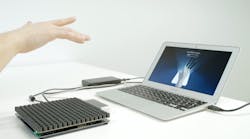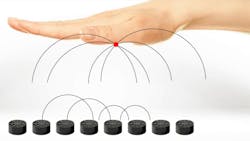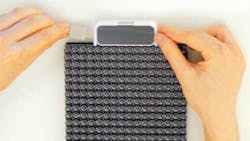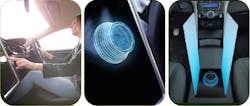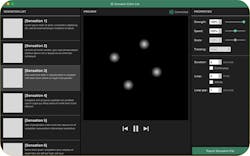Ultrahaptics hasn’t quite brought holodeck solidity to augmented or virtual reality applications, but it is a step in that direction. The company’s technology employs a phased array of ultrasonic speakers to deliver sound waves that reinforce each other, so that vibrations can be induced at a fixed position away from the array (Fig. 1). This is similar to how a phased-array radar system works.
The force on the skin of a hand is minute, but it provides sufficient haptic feedback—much like the vibrations of a smartphone when pressing a button on the screen. The difference is that the smartphone is in contact with a finger, while Ultrahaptics technology operates at a distance. The current incarnation can operate up to 2 m from a hand.
There is another aspect to this technology that is not shown in the diagram; the system needs to know where the target is located. In most cases this will be a hand or head, although it will work with most body parts when not covered by clothing. The missing piece is usually a 3D imaging system, the Leap Motion sensor used with the development kit (Fig. 2). Ultrahaptics’ technology is agnostic to the 3D imaging system.
I tried various demos recently and was suitably impressed by the feedback. For example, I could hold my hand a foot or more above an array to feel bubbles or water flowing by, and feel feedback when pressing a virtual button. The force is not sufficient to cause any significant movement or provide a solid surface (like a holodeck might), but it was more than sufficient to simulate surfaces and distinct objects.
3. Ultrahaptics technology could be employed in automotive settings providing touchless, virtual controls.
This basic augmented reality only required the use of Ultrahaptics hardware. The hardware can also be combined with augmented or virtual reality systems. One demo had me picking up and moving small balls and blocks.
One example where the more basic approach can be effective is with automotive controls (Fig. 3) or whitegood appliances. The system can easily simulate sliders, buttons, and knobs. It can even provide positioning information so a user can know by touch whether they are close to a control or control area, without looking at the area or having other visual feedback mechanisms.
4. The development tools allow designers to create different effects, including textured surface feedback.
Ultrahaptics includes tools (Fig. 4) that developers can use to create different effects and touch sensations. There are other changes in the works, like a custom ultrasonic speaker that is a fraction of the size of the current automotive solution. The automotive speakers are targeted side sensors for parking and object notification versus a dense array that Ultrahaptics needs.
Long-range haptic feedback is not needed for every application, but it offers significant and unique advantages for many applications. There are many possibilities for medical applications, as well.
